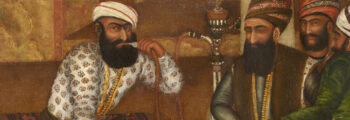Shisha through the generations
It surfaced in the form we know it as today around the 15th Century when Indian Glass manufacturing began as a result of the exporting of glass to India through the British East India Company.
Present day

Today, around the world, shisha has hardly broken from tradition as it is still revered as a way to show respect and provide good hospitality as it was 100s of years ago. Family members, close friends, and new acquaintances come together and deepen ties over a shisha in the same way it has been done for generations. Shisha is a part of an extensive community that brings people together despite social class, religion, or political beliefs. While there have been advancements in shisha over the years, the practice remains deeply rooted in tradition. And for many people spanning numerous nationalities, shisha is…a cultural expression.
21st century

In the early 21st Century, a Shisha industry has begun to surface across the world as early pioneers found ways to improve the quality of products using modern technology. Innovations in flavor choices beyond the traditional were also crafted to address the demands of current-day taste preference and variety.
20th century

Throughout the 20th Century, shisha traditions continued to deepen in cultures throughout India, Persia, Turkey, the Middle East, and in neighbouring countries such as Israel, Armenia, and Pakistan. However, by the late 1900s, shisha has migrated to virtually every continent as immigrants of these countries brought this custom with them to share a piece of their culture to the new world.
19th century

The Shisha tradition spread into the Middle East throughout the 19th century. In Egypt, traditional forms of tobacco seen prior were reformulated into Mu’Assel by mixing honey or molasses with the tobacco. Mu’Assel translates directly as “with honey” but this term generally refers to flavored tobacco as even dried lemon, grape, watermelon, and mint were added. Shisha integrated into society so deeply in these parts that shisha cafes were built to house the ever-growing popularity. Shisha promoted a community amongst the patrons, uniting all classes, races, and genders alike. It was used as a way for people to relax, socialize and strengthen bonds with one another.
18th century

Shisha migrated into Turkish culture and during the 18th century, it continued to blossom through means of more innovation. The dated look of the Shisha was phased out as blacksmiths began casting intricate brass designs and adorned the pipe with royal and religious markings. Shisha was prominent in Turkish high society and was a true symbol of status. It was smoked after royal dinners and at diplomatic
17th century

In the 17th century, Shisha became a part of Persian culture where strong, dark leaf tobacco called Ajami was used. Craftsmen took pride in the aesthetics and redefined the look of the pipe through woodworking. For the first time, Shisha became accessible to everyone and an industry of shisha servants
16th century

The first shisha in the form we know today dates back to 16th century India at a time when Indian glass manufacturing began as a result of the exporting of glass in India through the British East India Company. During this period, smoking tobacco also became popular amongst the noblemen in high society. In an attempt to purify smoke through water in a glass base called a “Shisha”, the Shisha was invented. Shisha soon cemented itself as a way for noblemen to show their high social status.
Come on down
Monday – Sunday
11.30AM – 12.00AM
Get in touch
Phone
0121 245 2229
info@shisha-wala.co.uk
Address
1066 Coventry Road
Birmingham
B25 8DP
